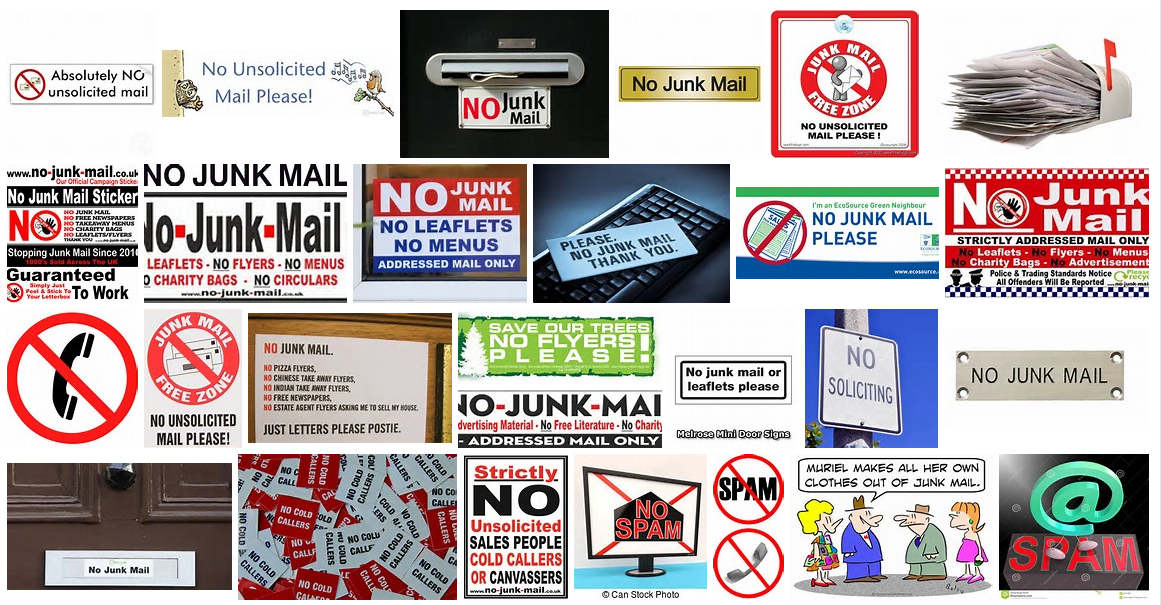Here is what ad blocking looks like in the physical world:

What we want to block in the online world is the same thing, only here it’s called adtech.
Like junk mail, adtech —
- wants to get personal,
- is data-driven,
- is based on as much tracking as possible,
- wants to follow you around (thats called “retargeting”)
- mistakes tolerance for approval,
- clogs distribution pipes,
- is mostly litter,
- cheapens its environment, and
- wastes time and space in our lives.
Worse, adtech is also a vector for malware and fraud. That’s because the supply chain for adtech could include any of the following things you’ve probably never heard of, and which together turn adtech into a four-dimensional shell game:
- Trading desks
- SSPs (Supply Side Platforms)
- DSPs (Demand Side Platforms)
- Ad exchanges
- RTB (real time bidding) and other auctions
- Retargeters
- DMPs (Data Management Platforms)
- Tag managers
- Tata aggregators
- Brokers
- Resellers
- Media management systems
- Ad servers
- Gamifiers
- Real time messagers
- Social tool makers
And those are just a few I’ve gathered by hearing adtech talk to itself. Ask any publisher to tell you exactly where any adtech-placed ad came from, and they won’t know. Refresh the page and chances are that other ads will appear in the same spaces, fed down through that four-dimensional matrix of possibilities.
Want to opt out? The Digital Advertising Alliance (DAA) wants you to click on a little Ad Choices button (placed in a corner of one of the minority of ads in which they appear), and then go through a series of clicks after that. And that’s only for a few participating companies. Ghostery has a much longer opt-out list. Go there and see how many times you need to hit Page Down before you reach the bottom. Yes, the adtech business is that huge.
And there’s no easy way to know if any of these companies respected your wishes.
In marketing lingo, adtech is a form of direct response marketing, which is descended from the direct (aka junk) mail business, not from Madison Avenue.
The difference is critical, because what we really need to block is adtech, not all of advertising.
The baby in the adblocking bathwater is Madison Avenue, which has paid for nearly everything on newsstands, radio and TV since their beginnings. Even if we didn’t like ads fattening our magazines and interrupting our shows, we knew the economic role they played, and we appreciated their best work.
Here are three other good things about Madison Avenue advertising:
- It isn’t personal.
- It isn’t based on tracking you.
- You know where it comes from.
In one simple word, it’s safe. You may not like it, but you don’t have to worry about it.
The simplest way to end to the adblock war is for non-tracking-based ads — the safe Madison Avenue kind — to carry a marker* that ad blockers can whitelist. I also recommended this in Separating Advertising’s Wheat and Chaff.
(Adblock Plus, the most popular ad blocker for Web browsers, has an “acceptable ads manifesto” and a whitelist. While that seems a worthy effort, there are two problems with it:
- It doesn’t make a sharp distinction between tracking and non-tracking based ads.
- Adblock Plus reportedly gets paid by Google for whitelisting “acceptable” ads, meaning that Adblock Plus is actually in the advertising business itself. (Sources: TechCrunch, Hacker News. Are those ads are aimed by tracking? Presumably.)
I also suggest that ad blockers call themselves adtech blockers, so it’s clear that the user’s problem is with the online equivalent of junk mail, and not with the kind of advertising that has supported commercial media for the duration.
As for people who want to be tracked, we’ll need an opt-in way provided by standards and code from .orgs on the individual’s side. But for now, let’s fix advertising by fixing ad blocking, and end this “war” that never should have happened.
At ProjectVRM we approve of ad and tracking blockers, because they meet the first requirement of VRM tools: they give us independence. They also give us agency: the power to act with effect in the world. That’s why we list many here on the VRM developments list.
The second requirement of VRM tools is engagement. So far, ad and tracking blockers don’t engage. They just block (or filter, such as with the EFF‘s Privacy Badger).
Some on the advertising side want to engage, and not to fight. In Dear Adblocking community, we need to talk, Chris Pedigo of Digital Content Next recognizes the legitimacy of ad blocking in response to bad acting by his industry, and outlines some good stuff they can do.
But they also need to see that it’s no longer up to just them. It’s up to us: the individual targets of advertising.
The only way engagement will work is through tools that are ours, and we control: tools that give us scale — like a handshake gives us scale. What engages us with the Washington Post should also engage us with Verge and Huffpo. What engages us with Mercedes should also engage us with a Ford dealer or a shoe store. That’s the next VRM challenge here.
Finally, for those who want to block all advertising, it’s cool that you’ve got the tools you want already. I’m sure they’ll get better too. Just bear in mind that there’s a difference between the ads that have sponsored publishing and broadcasting for the duration, and the junky stuff that has taught us to hate all advertising online, and created the market for ad blockers in the process.
*I don’t care who comes up with this, as long as it’s open source and everybody can adopt and/or respect it.
